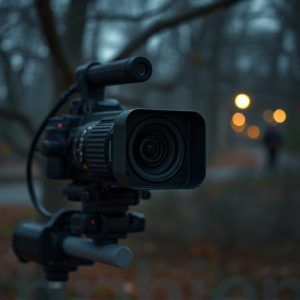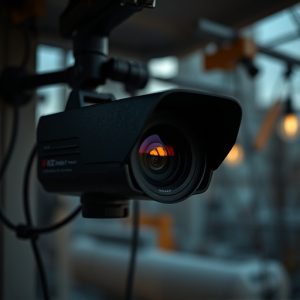Spy Camera Childcare Safety Guide: Placement, Detection & Legal Boundaries
The Spy Camera Childcare Safety Guide explores the delicate balance between enhancing childcare secu…….
The Spy Camera Childcare Safety Guide explores the delicate balance between enhancing childcare security through covert recording equipment and preserving privacy. It promotes responsible practices with emphasis on transparency, parental consent, legal compliance, and ethical standards in equipment placement. Effective strategies include discreet positioning in bustling areas like playrooms and dining halls, while avoiding private spaces. The guide equips parents and caregivers with tools to create secure environments, deterring unauthorized surveillance and fostering trust. By combining technology with open communication, childcare centers can ensure children's safety without compromising privacy.
In an era where privacy is a paramount concern, understanding covert recording equipment placement and detection is crucial for maintaining safe and trustworthy childcare environments. This comprehensive guide delves into the intricate world of spy cameras, offering a detailed overview of their application in childcare settings. From legal considerations to advanced detection techniques, we explore effective strategies for both deploying and preventing unauthorized surveillance, ensuring a Spy Camera Childcare Safety Guide for professionals and parents alike.
- Understanding Covert Recording Equipment: A Comprehensive Overview
- Legal Considerations and Ethical Boundaries in Childcare Settings
- Effective Placement Strategies for Spy Cameras in Daycares
- Advanced Detection Techniques to Prevent Unauthorized Surveillance
- Ensuring Safety and Trust: Best Practices for Monitoring with Spy Cameras
Understanding Covert Recording Equipment: A Comprehensive Overview
Covert recording equipment, often referred to as spy cameras, is a sensitive topic, especially in areas like childcare where trust and transparency are paramount. These devices are designed to capture footage or audio discreetly, making them nearly invisible to the naked eye. From tiny cameras hidden in pens to voice recorders disguised as everyday objects, their forms vary widely. The Spy Camera Childcare Safety Guide emphasizes responsible use, highlighting its benefits for ensuring safety while raising concerns about privacy invasion.
In childcare settings, covert recording can serve as a crucial tool for maintaining security and accountability. Caregivers can monitor interactions, verify activities, and protect children from potential harm. However, it’s essential to strike a balance between supervision and privacy. Parents and guardians should be made aware of these systems’ presence, their purpose, and the measures taken to safeguard personal information. Understanding how these devices work and where they might be placed is the first step in navigating this intricate issue.
Legal Considerations and Ethical Boundaries in Childcare Settings
In childcare settings, the placement and use of covert recording equipment raise complex legal and ethical concerns. While implementing spy camera childcare safety measures can aid in ensuring the well-being and security of children under care, it’s crucial to balance this with privacy rights. Many countries have strict regulations governing surveillance in such environments, focusing on protecting vulnerable populations from unwarranted intrusions.
The Spy Camera Childcare Safety Guide emphasizes responsible practices, advocating for transparency and parental consent. It’s essential for caregivers to understand the legal boundaries, ensuring equipment placement complies with local laws and ethical standards. Striking a delicate balance between safety measures and privacy is paramount to maintaining trust in childcare institutions.
Effective Placement Strategies for Spy Cameras in Daycares
In the realm of childcare safety, a comprehensive Spy Camera Childcare Safety Guide is an indispensable tool for parents and caregivers alike. Effective placement strategies for these devices are crucial to ensure a secure environment where children can thrive. When strategically implemented, spy cameras can serve as vigilant guardians, capturing moments and promoting transparency.
For daycares, the focus should be on discreet yet comprehensive coverage. Cameras should be positioned in common areas like playrooms and dining halls, where activities are bustling and interactions abundant. Additionally, consider corners and hidden spots often overlooked but prime for observation—a clever placement tactic to capture unscripted behavior. Remember, the goal is to create a sense of security without disrupting the natural flow of childcare operations.
Advanced Detection Techniques to Prevent Unauthorized Surveillance
In the digital age, where covert recording devices have become increasingly sophisticated, it’s crucial to arm oneself with advanced detection techniques to prevent unauthorized surveillance, especially in sensitive areas like childcare facilities. A comprehensive Spy Camera Childcare Safety Guide is essential for parents and caregivers to safeguard children from potential hidden threats. This involves a multi-layered approach that includes regular physical inspections, utilizing specialized equipment to detect infrared or heat signatures commonly used in spy cameras, and staying vigilant about unusual behavior or objects within the facility.
By combining these methods, childcare centers can create an environment that discourages the placement of covert recording devices. Regular training sessions for staff on surveillance detection techniques further enhance security measures. Additionally, promoting open communication between parents and caregivers fosters trust while ensuring any potential issues are promptly addressed.
Ensuring Safety and Trust: Best Practices for Monitoring with Spy Cameras
Ensuring safety and trust is paramount in environments like childcare facilities, where camera surveillance can be a powerful tool for monitoring and protection. When implementing spy cameras as part of a Childcare Safety Guide, it’s crucial to consider ethical boundaries and respect for privacy. The best practice is to gain transparent consent from parents or guardians, ensuring they are aware of the camera’s presence and its purpose.
Placement of these devices should be strategic and limited to areas where supervision is necessary, such as playrooms and common areas. It’s important to avoid covert placement in private spaces like children’s bedrooms, respecting their personal sanctuary. Regular maintenance and updates of the surveillance system are also key; ensuring cameras are functioning properly and data is securely stored. This practice fosters an environment of accountability, promoting safe and nurturing care while maintaining the trust between caregivers, parents, and the community.
In conclusion, a comprehensive understanding of covert recording equipment, its placement, and detection techniques is essential in ensuring safe and trustworthy childcare environments. This Spy Camera Childcare Safety Guide has equipped readers with valuable insights into navigating legal boundaries, implementing effective monitoring strategies, and fostering an environment where children’s well-being is paramount. By adopting these best practices, childcare facilities can create a secure setting while maintaining the trust of parents and guardians.


